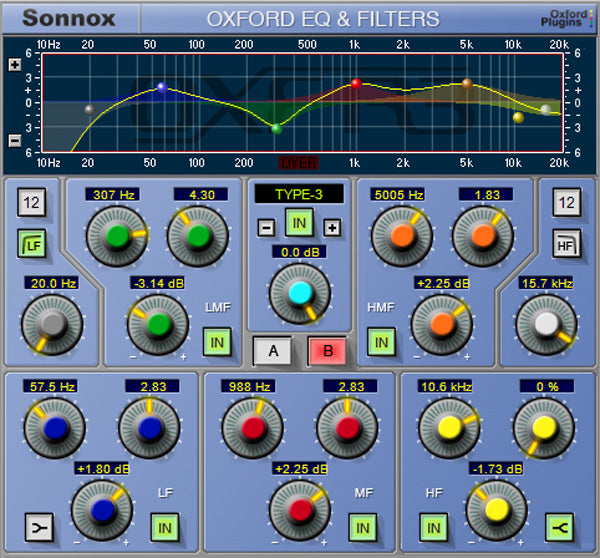Description
The Oxford EQ is based on the EQ section of the Sony OXF-R3. It is a 5-band plug-in with selectable shelf settings on LF and HF sections. Additionally, separate variable slope low pass and high pass filters are provided. The Oxford EQ also features 4 different selectable EQ types that cover most of the EQ styles currently popular amongst professional users, including some legacy styles which are renowned for their artistic capability. The use of novel coefficient generation and intelligent processing design provides unparalleled performance that surpasses analogue EQ in both sound quality and artistic freedom. This plug-in may well provide all the EQ you ever needed.
Sonnox Oxford EQ Types
There are 4 types of EQ as standard in the Sonnox Oxford EQ, plus an option for a fully approved GML 8200 emulation, for Pro Tools and HD. The differences between the types are reflected within the curve characteristics of the bell settings. The shelving curves are the same for all 4 types. They include the use of the 'Q' controls allowing and amount of 'undershoot' to be dialed in for boost settings, and overshoot when a shelf is used in cut settings. As an example, when applying an HF shelf, adding Q will cause the mid range just below the shelf to be cut, whilst simultaneously increasing the slope of the rise to the shelf. This has the effect of reducing perceived harshness, sweetening the sound, much like the legacy Neve and SSL G Series EQs.
EQ Type 1
This EQ can be regarded as a general and multi-purpose 'sharp' or clinical tool. Its response curves are very similar to that of the EQs in the SL4000E consoles, popular in the 80's. Characterized with minimal 'gain' verses 'Q' dependency, the shape of the peak of the boost and cut curves, when in 'bell', remain virtually constant according to the Q setting, no matter what level of boost or cut is in use. Even so, it is possible to mimic many other EQ types with Type 1, due to the flexibility of the control ranges. The boost and cut curves are mirror images of each other, termed reciprocal.
EQ Type 2
The boost curves are identical to Type 1, whereas the cut curves are tighter. In fact this is a true 'constant Q' equalizer where the cut curve is 3 times sharper than the boost curve, ideal for removing troublesome resonances.
EQ Type 3
This is a reciprocal EQ which has a moderate amount 'gain' verses 'Q' dependency. This means that at lower boost and cut settings, the shape of the curve is broader, becoming progressively sharper with increased boost or cut. This characteristic feels very comfortable to the ears and this type of EQ is often deemed musical, resembling older well-loved Neve types and the SSL G-Series which came along in the late 80's.
EQ Type 4
This type has the greatest 'gain' verses 'Q' dependency. It's characteristics are very soft and gentle, likely to be extremely useful in mastering situations.
- iLok USB device. iLok2 / iLok3 required with latest drivers
- iLok Cloud. Active internet connection required

